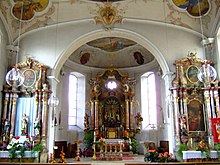St. Remigius (Dahenfeld)
The parish church of St. Remigius is the parish church of the Catholic parish of St. Remigius in Dahenfeld , a district of Neckarsulm in the Heilbronn district . It was built between 1738 and 1748 as a pilgrimage church in the Baroque style in place of an older church building. After the pilgrimage lost its importance in the early 19th century, the listed church has been used as a normal parish church to this day.
history
A church in Dahenfeld is first mentioned in 1319, but the church patron Remigius suggests an older origin in the days of the Franks . The church is described in 1604 as "quite small and bawfellig". In 1595 a “thunderstorm” had damaged their tower, which therefore had to be partially dismantled in 1623, whereupon moisture could penetrate and cause further damage. During the Thirty Years' War , Croatians and Hungarians attacked Dahenfeld in 1637 and burned down the church. In 1656 a parish could be celebrated in the restored building, but already in 1692 rain poured into the church again, and in the following decades the condition of the church deteriorated so that by 1736 cracks had appeared in the masonry, the front gable had to be held together by clips and churchgoers fell ill because of the serious moisture problem.
On August 10, 1735, on Laurentius Day , the Dahenfeld pastor Johann Georg Joseph Sutor and the visitors of Vespers wanted to have observed that "sweat, mixed with blood" had emerged from the Jesus figure on the crucifix of the Dahenfeld church. After the report of this apparition, a lively pilgrimage to the Holy Cross quickly began, and some pilgrims reported that they had been helped in their need. After the miraculous apparition was repeated a year later, on some days over 1000 pilgrims stayed in Dahenfeld, which then had around 250 inhabitants. The dilapidated church was not able to cope with this onslaught, and at the end of 1738 the builder Franz Häffele , who was hired for this purpose, began a new construction of the church made possible by sacrificial money from the pilgrims; The foundation stone was laid on May 26, 1739. Financial bottlenecks caused the construction to stall several times, but fundraising and petitions by the pastor as well as generous financial support from the Gundelsheim Teutonic Order Commander Johann Christoph von Buseck made the inauguration possible on October 24, 1748 after ten years of construction.
By the 1830s at the latest, the pilgrimage to the Holy Cross declined after the church had pushed back pilgrimage. Despite the brief resurgence of the pilgrimage in the middle of the 19th century, Dahenfeld did not regain its former importance as a place of pilgrimage.
Since its completion, the church building had to be renovated again and again. The church tower was repaired in 1925, as well as in 1953 and 2001. Interior renovations were carried out in 1936, 1940, 1973 and 1975, in 1978/79 the outer facade and the roof were renovated and a new tower clock was installed, in 2004 the west gable was renovated and the masonry drained. In 2009 the interior and the roof of the church were renovated again.
description
St. Remigius is an aisle church with a choir in the east in an apse and a 33 meter high church tower attached to the north, in which four bronze bells have been hanging since 1990, following earlier bells. The interior is adorned with stucco ornaments and baroque wall and ceiling paintings; the main painting shows the bodily absorption of Mary into heaven. The coat of arms of the church patron of Buseck can also be found.
The main altar , consecrated to the Holy Cross and designed by Viktor Geiselhardt from Ellwangen, dates from the 1970s and integrates various components of earlier altars. Its heart, the Holy Cross, has been in Dahenfeld since 1647. The current main altar replaced an altar in the neo-renaissance style from 1882, which had also integrated parts of an older baroque altar. The left side altar consecrated to Mary shows God the Father, a Madonna painting held by angels after the miraculous image of Mariahilf by Lucas Cranach the Elder. Ä. as well as Maria's parents Joachim and Anna. The right side altar is consecrated to the church patron St. Remigius and shows besides him (at the baptism of Clovis ) the saints Joseph, George and Elisabeth of Thuringia. All three altars also show the Buseck coat of arms.
The pulpit probably dates from the 1780s. The gallery was once designed as a double gallery, but was later replaced by a single gallery that houses a Späth organ from 1909. In addition to the ones mentioned, many other paintings and figures decorate the church.
literature
- Martin Bauer: The pilgrimage church of St. Remigius in Dahenfeld . In: The churches of Neckarsulm . 1st edition. Kunstverlag Josef Fink, Lindenberg 2004, ISBN 3-89870-164-6 , p. 20-29 .
Web links
Individual evidence
- ↑ a b Andreas Bracht: Church of St. Remigius in Dahenfeld is being renovated with the help of the city, press release of the city of Neckarsulm from January 29, 2009
- ↑ a b c Quoted from Bauer (see literature), p. 20
- ↑ Martin Bauer: From the rectory to the parish hall (Festschrift) . Ed .: Catholic parish of St. Remigius. Dahenfeld 2017, p. 18 .
Coordinates: 49 ° 12 ′ 31 ″ N , 9 ° 18 ′ 2 ″ E










